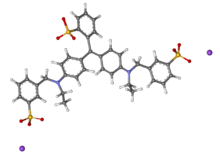Brilliant blue FCF

| |

| |
| Names | |
|---|---|
| IUPAC name
ethyl - [4 - [ [4 - [ethyl -[(3 - sulfophenyl) methyl] amino] phenyl] - (2 - sulfophenyl) methylidene] - 1 - cyclohexa - 2, 5 - dienylidene] - [(3 - sulfophenyl) methyl] azanium
| |
| Other names | |
| Identifiers | |
3D model (JSmol)
|
|
| ChEMBL | |
| ChemSpider | |
| ECHA InfoCard | 100.021.219 |
| E number | E133 (colours) |
PubChem CID
|
|
| UNII | |
CompTox Dashboard (EPA)
|
|
| |
| |
| Properties | |
| C37H34N2Na2O9S3 | |
| Molar mass | 792.85 g/mol |
| soluble | |
| Hazards | |
| NFPA 704 (fire diamond) | |
Except where otherwise noted, data are given for materials in their standard state (at 25 °C [77 °F], 100 kPa).
| |
Brilliant Blue FCF (Blue 1) is an organic compound classified as a Triarylmethane dye, reflecting its chemical structure. Known under various commercial names, it is a colorant for foods and other substances. It is denoted by E number E133 and has a color index of 42090. It has the appearance of a reddish-blue powder. It is soluble in water, and the solution has a maximum absorption at about 628 nanometers.
Production
It is a synthetic dye produced by the condensation of 2-formylbenzenesulfonic acid and the appropriate aniline followed by oxidation.[2] It can be combined with tartrazine (E102) to produce various shades of green.
It is usually a disodium salt. The diammonium salt has CAS number . Calcium and potassium salts are also permitted. It can also appear as an aluminium lake. The chemical formation is C37H34N2Na2O9S3.
Related dyes are C.I. acid green 3 (CAS#4680-78-8) and acid green 9 (CAS#4857-81-2). In these dyes, the 2-sulfonic acid group is replaced by H and Cl, respectively.[3]
Applications
As a blue color, Brilliant Blue FCF is often found in ice cream, canned processed peas, packet soups, bottled food colorings, icings, ice pops, blue raspberry flavored products, dairy products, sweets[4] and drinks, especially the liqueur blue curaçao. It is also used in soaps, shampoos, mouthwash[5] and other hygiene and cosmetics applications. In soil science, Brilliant Blue is applied in tracing studies to visualize infiltration and water distribution in the soil. In the United States, of the two approved blue dyes (the other being Indigo carmine, or FD&C Blue #2), Brilliant Blue FCF is the more common of the two.
Health and safety

The dye is poorly absorbed from the gastro-intestinal tract and 95% of the ingested dye can be found in the feces.
Brilliant Blue FCF is an approved food colorant and pharmacologically inactive substance for drug formulations in the EU and the United States. It is also legal in other countries. It has the capacity for inducing allergic reactions in individuals with pre-existing moderate asthma.[6] In 2003, the U.S. FDA issued a public health advisory to warn health care providers of the potential toxicity of this synthetic dye in enteral feeding solutions.[7] The following legal limits apply in the EU (E 131) and other countries: 150-300 mg/kg depending on the type of food. Safety limit for foods and drugs: 0.1 mg/day per kg body weight.[8] The ADI for Brilliant Blue FCF is 10 mg/kg.
Biomedical research
Scientists who were conducting in-vivo studies of compounds to lessen the severity of inflammation following experimental spinal cord injury had previously tested a compound called OxATP to block a key ATP receptor in spinal neurons. However, OxATP has toxic side effects and must be injected directly into the spinal cord; in searching for alternatives they noted that Brilliant Blue FCF has a similar structure. This led them to test a related dye, Brilliant Blue G (also known as Coomassie Brilliant Blue) in rats, which improved recovery from spinal cord injury.[9]
References
- ^ "Erioglaucine disodiumsalt" (PDF). Acros Organics. Retrieved 10 March 2016.
- ^ El Ali, Bassam M.; Bassam El Ali; Ali, Mohammad Farahat (2005). Handbook of industrial chemistry: organic chemicals. New York: McGraw-Hill. ISBN 0-07-141037-6.
{{cite book}}: CS1 maint: multiple names: authors list (link) - ^ Thomas Gessner and Udo Mayer "Triarylmethane and Diarylmethane Dyes" in Ullmann's Encyclopedia of Industrial Chemistry 2002, Wiley-VCH, Weinheim.doi:10.1002/14356007.a27_179
- ^ Nestle Aero packet ingredients listing barcode: 7613031579334
- ^ "LISTERINE Antiseptic Mouthwash, SMART RINSE, WHITENING, ADVANCED, Fluoride Rinse, and Tartar Protection Products". Listerine.com. Retrieved 2009-07-31.
- ^ J. Allergy Clin. Immunol.; VOL 64 ISS Jul 1979, P32-37, (REF 25)
- ^ FD&C Blue No. 1. Retrieved 16 November, 2013
- ^ zusatzstoffe-online.de: E133
- ^ Peng, Weiguo; Maria L. Cotrinaa; Xiaoning Hana; Hongmei Yua; Lane Bekara; Livnat Bluma; Takahiro Takanoa; Guo-Feng Tiana; Steven A. Goldmanb; Maiken Nedergaard (July 28, 2009). "Systemic administration of an antagonist of the ATP-sensitive receptor P2X7 improves recovery after spinal cord injury". Proceedings of the National Academy of Sciences of the United States of America. 106 (30): 12489–12493. doi:10.1073/pnas.0902531106. PMC 2718350. PMID 19666625. Retrieved 1 April 2010.
- W. H. Hansen; O. G. Fitzhugh; A. A. Nelson; K. J. Davis (1966). "Chronic toxicity of two food colors, Brilliant Blue FCF and Indigotine". Toxicology and Applied Pharmacology. 8 (1): 29–36. doi:10.1016/0041-008X(66)90097-4. PMID 5950860.
- J. F. Borzelleca; K. Depukat; J. B. Hallagan (1990). "Lifetime toxicity/carcinogenicity studies of FD & C blue No. 1 (Brilliant blue FCF) in rats and mice". Food and Chemical Toxicology. 28 (4): 221–235. doi:10.1016/0278-6915(90)90034-K.
- J. P. Brown; A. Dorsky; F. E. Enderlin; R. L. Hale; V. A. Wright; T. M. Parkinson (1980). "Synthesis of 14C-labelled FD & C blue no. 1 (brilliant blue FCF) and its intestinal absorption and metabolic fate in rats". Food and Cosmetics Toxicology. 18 (1): 1–5. doi:10.1016/0015-6264(80)90002-4.

